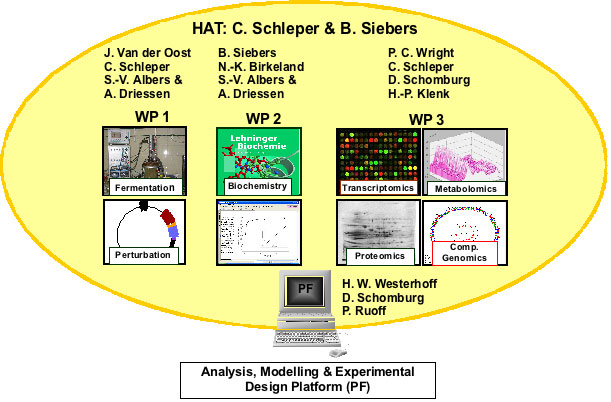Systems Biology: “SulfoSYS”

The archaeal model organism of choice for a systems biology approach is Sulfolobus solfataricus, a thermoacidophilic Crenarchaeon that grows at around 80°C and pH 3 (Zillig et al. 1980, Arch. Microbiol. 125, 259-269). S. solfataricus uses an unusual branched Entner-Doudoroff (ED) pathway for glucose catabolism (Ahmed et al. 2005). Life at high temperature requires a very efficient adaptation to temperature changes, which is most difficult to deal with for organisms. Presently, it is unclear how biological networks can withstand and respond to such changes. The SulfoSYS project is funded in the course of the transnational SysMO “Systems Biology of Microorganisms” project and the German partners are supported by the BMBF. In the SulfoSYS project, which is performed by 10 European partners (see below), we will study the central carbohydrate metabolism (CCM), i.e. the branched ED pathway of S. solfataricus and its regulation under temperature variation by the integration of genomic, transcriptomic, proteomic, metabolomic, kinetic and biochemical information. The long-term goal of the project is to build a sufficiently precise replica for this part of the living cell (“a Silicon Cell”) to enable computation of life, particularly its robustness to changes in temperature, at the system level.
Partners
- Prof. Dr. Christa Schleper, University of Vienna, Austria
- Prof. Dr. Bettina Siebers, University of Duisburg-Essen, Germany
- Dr. Sonja-Verena Albers & Prof. Dr. Arnold J. M. Driessen, University of Groningen, The Netherlands
- Prof. Dr. Nils-Kåre Birkeland, University of Bergen, Norway
- Dr. Hans-Peter Klenk, DSMZ Braunschweig, Germany
- Prof. Dr. Peter Ruoff, University of Stavanger, Norway
- Prof. Dr. Dietmar Schomburg, Technical University Braunschweig, Germany
- Prof. Dr. John Van der Oost, Wageningen University, The Netherlands
- Prof. Dr. Hans W. Westerhoff, Free University Amsterdam, The Netherlands / University of Manchester, The United Kingdom
- Prof. Dr. Phillip C. Wright, University of Sheffield, The United Kingdom
Project structure

